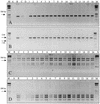In situ transfer of antibiotic resistance genes from transgenic (transplastomic) tobacco plants to bacteria
- PMID: 12089013
- PMCID: PMC126776
- DOI: 10.1128/AEM.68.7.3345-3351.2002
In situ transfer of antibiotic resistance genes from transgenic (transplastomic) tobacco plants to bacteria
Abstract
Interkingdom gene transfer is limited by a combination of physical, biological, and genetic barriers. The results of greenhouse experiments involving transplastomic plants (genetically engineered chloroplast genomes) cocolonized by pathogenic and opportunistic soil bacteria demonstrated that these barriers could be eliminated. The Acinetobacter sp. strain BD413, which is outfitted with homologous sequences to chloroplastic genes, coinfected a transplastomic tobacco plant with Ralstonia solanacearum and was transformed by the plant's transgene (aadA) containing resistance to spectinomycin and streptomycin. However, no transformants were observed when the homologous sequences were omitted from the Acinetobacter sp. strain. Detectable gene transfer from these transgenic plants to bacteria were dependent on gene copy number, bacterial competence, and the presence of homologous sequences. Our data suggest that by selecting plant transgene sequences that are nonhomologous to bacterial sequences, plant biotechnologists could restore the genetic barrier to transgene transfer to bacteria.
Figures



Similar articles
-
Detection of potential transgenic plant DNA recipients among soil bacteria.Environ Biosafety Res. 2007 Jan-Jun;6(1-2):71-83. doi: 10.1051/ebr:2007036. Epub 2007 Oct 26. Environ Biosafety Res. 2007. PMID: 17961481
-
Exploration of horizontal gene transfer between transplastomic tobacco and plant-associated bacteria.FEMS Microbiol Ecol. 2011 Oct;78(1):129-36. doi: 10.1111/j.1574-6941.2011.01126.x. Epub 2011 May 31. FEMS Microbiol Ecol. 2011. PMID: 21564143
-
Leaf-feeding larvae of Manduca sexta (Insecta, Lepidoptera) drastically reduce copy numbers of aadA antibiotic resistance genes from transplastomic tobacco but maintain intact aadA genes in their feces.Environ Biosafety Res. 2007 Jan-Jun;6(1-2):121-33. doi: 10.1051/ebr:2007028. Epub 2007 Oct 26. Environ Biosafety Res. 2007. PMID: 17961486
-
Long-term persistence and bacterial transformation potential of transplastomic plant DNA in soil.Res Microbiol. 2010 Jun;161(5):326-34. doi: 10.1016/j.resmic.2010.04.009. Epub 2010 May 20. Res Microbiol. 2010. PMID: 20493252
-
An assessment of the risks associated with the use of antibiotic resistance genes in genetically modified plants: report of the Working Party of the British Society for Antimicrobial Chemotherapy.J Antimicrob Chemother. 2004 Mar;53(3):418-31. doi: 10.1093/jac/dkh087. Epub 2004 Jan 28. J Antimicrob Chemother. 2004. PMID: 14749339 Review.
Cited by
-
Sexual isolation in Acinetobacter baylyi is locus-specific and varies 10,000-fold over the genome.Genetics. 2009 Aug;182(4):1165-81. doi: 10.1534/genetics.109.103127. Epub 2009 May 27. Genetics. 2009. PMID: 19474200 Free PMC article.
-
Symbiotic nitrogen fixation and endophytic bacterial community structure in Bt-transgenic chickpea (Cicer arietinum L).Sci Rep. 2020 Mar 25;10(1):5453. doi: 10.1038/s41598-020-62199-1. Sci Rep. 2020. PMID: 32214159 Free PMC article.
-
Next-generation marker-free transplastomic plants: engineering the chloroplast genome without integration of marker genes in Solanum tuberosum (potato).Plant Cell Rep. 2024 Nov 22;43(12):290. doi: 10.1007/s00299-024-03375-9. Plant Cell Rep. 2024. PMID: 39578272
-
Marker-Free Transplastomic Plants by Excision of Plastid Marker Genes Using Directly Repeated DNA Sequences.Methods Mol Biol. 2021;2317:95-107. doi: 10.1007/978-1-0716-1472-3_4. Methods Mol Biol. 2021. PMID: 34028764
-
Degradation and transformability of DNA from transgenic leaves.Appl Environ Microbiol. 2003 Jan;69(1):673-8. doi: 10.1128/AEM.69.1.673-678.2003. Appl Environ Microbiol. 2003. PMID: 12514059 Free PMC article.
References
-
- Bendich, A. J. 1987. Why do chloroplasts and mitochondria contain so many copies of their genome? Bioessays 6:279-282. - PubMed
-
- Bertolla, F., A. Frostegard, B. Brito, X. Nesme, and P. Simonet. 1999. During infection of its host, the plant pathogen Ralstonia solanacearum naturally develops a state of competence and exchanges genetic material. Mol. Plant-Microbe Interact. 12:467-472.
-
- Bertolla, F., and P. Simonet. 1999. Horizontal gene transfers in the environment: natural transformation as a putative process for gene transfers between transgenic plants and microorganisms. Res. Microbiol. 150:375-384. - PubMed
-
- Boucher, C. A., P. A. Barberis, A. P. Trigalet, and D. A. Demery. 1985. Transposon mutagenesis of Pseudomonas solanacearum: isolation of Tn5 induced avirulent mutants. J. Gen. Microbiol. 131:2449-2457.
Publication types
MeSH terms
LinkOut - more resources
Full Text Sources

